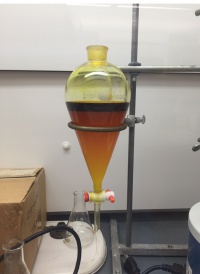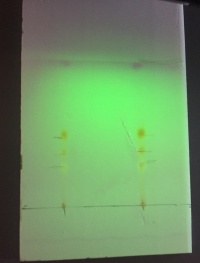Difference between revisions of "Curcumin Research"
| Line 8: | Line 8: | ||
Curcumin I (Main Curcuminoid, in picture below), demethoxycurcumin (curcumin II), and bisdemethoxycurcumin (curcumin III) are the three major curcuminoids present in turmeric and of interest to this study. Their respective chemical structures are depicted below: | Curcumin I (Main Curcuminoid, in picture below), demethoxycurcumin (curcumin II), and bisdemethoxycurcumin (curcumin III) are the three major curcuminoids present in turmeric and of interest to this study. Their respective chemical structures are depicted below: | ||
| − | [[Media:Curcuminoid Analogs with Potent Activity.pdf|Curcuminoid Analogs with Potent Activity (Article)]] | + | Structures retrieved from: [[Media:Curcuminoid Analogs with Potent Activity.pdf|Curcuminoid Analogs with Potent Activity (Article)]] |
[[File:Curcumin.jpg|400px|thumb|none|Curcumin I, II, and III]] | [[File:Curcumin.jpg|400px|thumb|none|Curcumin I, II, and III]] | ||
Revision as of 23:29, 10 May 2018
You have reached the page dedicated to the research of curcumin, a secondary plant metabolite and biophenol of interest to the Sturgeon Research Project. This page was created by Stephanie Saey and Nadia Ayala. Nadia was a 2017 Biochemistry graduate and Stephanie was a 2018 Biochemistry/Biopsychology graduate.
Abstract
Turmeric, Curcuma longa, is a traditional Indian spice with potential chemotherapeutic, pharmacological, anti-inflammatory, and antioxidative properties. The active component in turmeric, known as curcumin, is what allows the plant to house its well-documented health benefits. Curcumin has three derivatives of different molecular structures: curcumin (I), demethoxycurcumin (II), and bisdemethoxycurcumin (III). Taken together, these structures are referred to as curcuminoids. Due to the safety and availability of turmeric, many studies have reported techniques for isolating and purifying the curcuminoids through methods such as extraction coupled with column chromatography. However, to date, no such methods have been used to prepare large amounts of each curcuminoid individually. Curcumin I is only available in small amounts, while II and III remain unavailable commercially. The current research project aims to successfully isolate (methanol in soxhlet), purify (flash chromatography/HPLC), and characterize (NMR) the curcuminoids (I/II/III) in amounts large enough for further investigation on its radicalisation properties.
The Three Curcuminoids
Curcumin I (Main Curcuminoid, in picture below), demethoxycurcumin (curcumin II), and bisdemethoxycurcumin (curcumin III) are the three major curcuminoids present in turmeric and of interest to this study. Their respective chemical structures are depicted below:
Structures retrieved from: Curcuminoid Analogs with Potent Activity (Article)
Written Report
1. Descriptive information
Isolation and Purification of Curcuminoids from Tumeric Plant Curcuma Longa
Stephanie Saey, Nadia Ayala, and Bradley E. Sturgeon
Special thanks to Michael Prinsell and Broddie Davis
Research work documented in lab notebooks.
3. Background from earlier reports
Stephanie Saey and Nadia Ayala are the first Monmouth College Chemistry students to work on this specific research project involving turmeric.
4. Experimental
- Sourcing turmeric:
In order to proceed with the proposed research project, we needed to purchase turmeric from a reliable, science-conscious company. We chose to order 1 lb of organic and 1 lb of non-organic turmeric from Starwest Botanicals here.
Procedure for extraction was modeled after the following study: Kiuchi, F, Goyto, Y, Sugimoto, N, Akao, N, Kondo, K, Tsuda, Y. Nematocidal activity of turmeric: synergistic action of curcuminoids. Chem Pharm Bull (Tokyo) 1993;41:1640-3.
- Methanol in Soxhlet Extraction:
- 1. Soxhlet apparatus was set up for extraction, as pictured in Image A.
- 2. Approximately 76 grams of organic turmeric from Starwest Botanicals was added to the thimble.
- 3. Approximately 350 mL of MeOH was added to the stillpot and a few boiling stones were added.
- 4. Heat source and water source were turned on.
- 5. Extraction was ran for 6 hours.
- Removal of MeOH and Impurities:
- 1. MeOH/curcuminoid mixture in the stillpot (from extraction) was transferred to an 1000mL separatory funnel.
- 2. 275 mL of ethyl acetate (EtOAc) and 150 mL of water were added to the funnel, along with 150 mL brine solution.
- 3. The stopcock was added to the funnel and the mixture was inverted and vented multiple times for 1 minute.
- 4. The stopcock was removed, allowing the mixture to separate into two separate phases, one containing EtOAc and curcuminoids, and the other containing MeOH, water, and impurities. Image B displays this separated mixture.
- 5. The EtOAc/curcuminioid phase (top layer) was drained into a labeled glassware container.
- 6.The bottom layer was readded to the separatory funnel along with 150 mL of EtAOc, 150 mL water, and 100 mL brime.
- 7. Again, the stopcock was added to the funnel and the mixture was inverted and vented multiple times for 1 minute.
- 8. The stopcock was removed and the mixture was allowed to separate.
- 9. The top layer was added to the labeled glassware and the bottom layer was discarded.
- Thin Layer Chromatography
- A 5x10cm RediSep silica TLC plate was used to run TLC on the EtOAc/curcuminoid extract. First, 45 mL of the extract was diluted in 25 mL of ethyl acetate. A thin pencil line was drawn horizontally approximately 1.5 cm from the bottom of the plate. Two dots of the diluted extract were placed 4 cm apart on this line in order to conduct two trials on the same plate. An 8:1 chloroform:acetone solvent mixture was used. The fractions were allowed to follow the solvent up the plate and the results were imaged as shown in Figure A. Final Rf values were recorded.
- Flash Column Chromatography:
- A 15.5mL(13g) gold C18 reverse phase Column was used to run 1mL of the EtOAc/curcuminoid extract. This column uses acetyl nitrile and acidic(TFA 0.1%) water to run the liquid phase through the column.
- A gradient was ran for 25 min that yielded three distinct peaks. The eluents for each peak were collected and stored in separate viles.
- High Pressure Liquid Chromatography (HPLC):
- Each 1mL of each Flash eluent was added to a separate HPLC vile and labeled to be compared to the original Curcumin solution extracted through Soxhlet extraction.
- Rotovaporization:
- Each fraction of curcumin had its solvent extracted via rotovaportization. The hot bathwater was held at 32 degrees Celsius for about an hour and a half or until completely dry. Spin speed was between 9 and 10, and adjustments in the angle of inundation of the round bottom flask containing the curcumin fractions was adjusted as the solvent was vaporized.
- Nuclear Magnetic Resonance (NMR) Testing:
- About 1mg of each curcumin was added to separate NMR tubes. 1mL of duderated DMSO was added to resuspend the curcumin samples to be used in the 400Hz NMR at Knox College.
5. Results
- TLC Results
- TLC results from two trials of the diluted EtOAc/curcuminoid mixture (prepared from MeOH in soxhlet extraction) are shown in Figure A. A RediSep silica TLC plate was used with an 8:1 chloroform:acetone solvent front. Three distinct lines are visible for each trial, consistent with the three different curcuminoid structures. Rf values are as follows (same for each trial): .25, .375, .5.
- Flash Chromatography Results
- With the use of a C18 reverse phase column we successfully separated Curcumin I, II, and III from the original solution. The base line resolution of the curcumin fractions wasadjusted by increasing the run time from the original C18 procedure from 15 min to 25 min.
Curcumin Flash Chromatography Image
- HPLC Results
- Having separated the three curcumin through flash chromatography, purity of the sample was tested using flash chromatography using the original solution as a basis of comparison.
- NMR Results
- The concentration of our curcumins where not significant enough to have transmitted a high signal in the NMR for what we precive to be curcumin II and Curcumin III. However, the NMR results for Curcumin II are seen below.
6. Discussion
The flash chromatography and HPLC data have been consistent with the literature regarding the existence of curcumin's three different molecular structures. However, characterization of curcumins through NMR have led to further questions on the structures present within each curcumin sample. Further interpretation and testing are been necessary to have certainty in the purity of our samples as well as specific characterization of each fraction.
7. Conclusions
No final conclusions have been reached at this point, as we are still waiting to collect NMR results. The results of the NMR should tell us how successful our method was in isolating and purifying curcuminoids I,II, and III.
8. Future Directions
We plan to continue this research project into the second semester of the 2016-17 school year (and beyond). First on our agenda will be to collect NMR data on the three separate curcuminoids that were rotovapped from the separate flash eluents. NMR data will be collected both at Monmouth College and Knox College. Results will indicate the success of our methods, and lead us to either additional method development or mass quantification using the latest method.
10. Literature references
Goel A., Kunnumakkara A.B., Aggarwal B.B. (2008). Curcumin as ‘curecumin’: from kitchen to clinic. Biochem Pharmacology. pp. 787–809, doi:10.1016/j.bcp.2007.08.016
Jayaprakasha, G. K., Gowda, G. A. N., Marquez, S., & Patil, B. S. (2013). Rapid separation and quantitation of curcuminoids combining pseudo two dimensional liquid flash chromatography and NMR spectroscopy. Journal of Chromatography. B, Analytical Technologies in the Biomedical and Life Sciences, pp. 937, doi:10.1016/j.jchromb.2013.08.011
Kiuchi, F, Goyto, Y, Sugimoto, N, Akao, N, Kondo, K, Tsuda, Y. Nematocidal activity of turmeric: synergistic action of curcuminoids. (1993). Chem Pharm Bull (Tokyo) pp. 1640-3.
10. Signature
Two copies of the report will be signed and dated and turned in to the Faculty Research Advisor and archived by the Research Coordinator.






